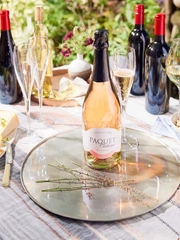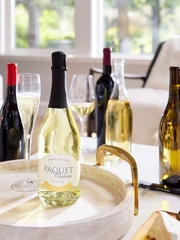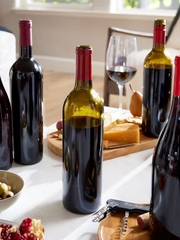As a kid, I was always fascinated by war planes and I spent many hours gluing models together. What kid is not attracted to flying machines? Recently, I was talking to a vineyard manager about a different kind of flying machine: drones.
Aerial precision analysis was initially used by Midwest farmers to manage corn, soybean, sugar beets and other traditional crops. Computer imagery and aerial technology from advanced platforms such as satellites, modern aircraft and remotely-piloted aerial systems (commonly referred to as drones) are increasingly being used in modern viticulture and vine growing.
All plants absorb and reflect wavelengths of light. Color infrared imagery (CIR) collected by drones can help a vineyard manager detect issues with the vines before they are even visible to the human eye. The Normalized Differential Vegetation Index (NDVI) is an imagery analysis tool used to measure plant vigor and biomass through color association. This technology allows one to take swift action on diseases, or determine a better watering and fertilization regimen.
Satellite image:
 Drone image:
Drone image:

Within the last ten years, the use of drones have been implemented in many vineyards. The highest resolution available through satellites or planes is around 20 inches/pixel, which is too low of a resolution to fully monitor vine leaves, shoots and soil. Sensors onboard unmanned airborne vehicles like drones offer a higher resolution at a fraction of the cost.
In 2002, large wineries in Oregon and Washington tested drone technology to determine the health of their “leafy plant material” or vines. Soon, winemakers could tell that vigorous areas on their aerial infrared images had fruits with shade, large berries with lower Brix (sugar content) and delays in ripening. However, less vigor indicated stressed areas with smaller berries, more flavor, higher Brix and early ripening. Harvesting decisions started to be made a few feet in the air by combing sections of the vineyard that had the same favorable NDVI.
Now drones are also used to determine new suitable land to plant. Vine row orientation, good soil, the amount of daily sunlight and adequate air flow are all important parameters to be considered. Federal agencies are now making this data free and available to the public.

Before, farmers had to walk the rows in order to see what was happening with the vines. Now when they go into the vineyard, they already know what’s wrong.
Programs like GreenSeeker are being used in California to collect extremely accurate NDVI readings. GreenSeeker optically scans the vineyard canopy from just a few feet above the row and calculates NDVI conditions instantaneously. Each drone is outfitted with a near-infrared camera, and it collects between four and nine gigabytes of data for every 250 acres it covers. The costs associated with vineyard establishment can often take years to recover. However, the use of this technology can help reduce risk and improve vineyard management in the long run, benefitting the bottom line.

Some industry analysts believe that the opportunity for using drones is huge for protecting honey bees, saving water and improving crop yields around the world. They estimate that
80 percent of the world’s drones will be put to work in the agriculture industry by the year 2020. One company is even developing a new ground drone that will detect vine-attacking diseases and spray pesticides directly on the affected areas. This targeted approach will help farmers around the world avoid widespread crop-dusting, which would reduce the use of pesticides that are harmful for humans and bees.
Drone technology and its application in vineyards improves grape productivity and sustainability in the wine industry – which is something all of us wine lovers can appreciate. I’d say that the future of wine is looking up!
 Drone image:
Drone image:
 Within the last ten years, the use of drones have been implemented in many vineyards. The highest resolution available through satellites or planes is around 20 inches/pixel, which is too low of a resolution to fully monitor vine leaves, shoots and soil. Sensors onboard unmanned airborne vehicles like drones offer a higher resolution at a fraction of the cost.
In 2002, large wineries in Oregon and Washington tested drone technology to determine the health of their “leafy plant material” or vines. Soon, winemakers could tell that vigorous areas on their aerial infrared images had fruits with shade, large berries with lower Brix (sugar content) and delays in ripening. However, less vigor indicated stressed areas with smaller berries, more flavor, higher Brix and early ripening. Harvesting decisions started to be made a few feet in the air by combing sections of the vineyard that had the same favorable NDVI.
Now drones are also used to determine new suitable land to plant. Vine row orientation, good soil, the amount of daily sunlight and adequate air flow are all important parameters to be considered. Federal agencies are now making this data free and available to the public.
Within the last ten years, the use of drones have been implemented in many vineyards. The highest resolution available through satellites or planes is around 20 inches/pixel, which is too low of a resolution to fully monitor vine leaves, shoots and soil. Sensors onboard unmanned airborne vehicles like drones offer a higher resolution at a fraction of the cost.
In 2002, large wineries in Oregon and Washington tested drone technology to determine the health of their “leafy plant material” or vines. Soon, winemakers could tell that vigorous areas on their aerial infrared images had fruits with shade, large berries with lower Brix (sugar content) and delays in ripening. However, less vigor indicated stressed areas with smaller berries, more flavor, higher Brix and early ripening. Harvesting decisions started to be made a few feet in the air by combing sections of the vineyard that had the same favorable NDVI.
Now drones are also used to determine new suitable land to plant. Vine row orientation, good soil, the amount of daily sunlight and adequate air flow are all important parameters to be considered. Federal agencies are now making this data free and available to the public.
 Before, farmers had to walk the rows in order to see what was happening with the vines. Now when they go into the vineyard, they already know what’s wrong.
Programs like GreenSeeker are being used in California to collect extremely accurate NDVI readings. GreenSeeker optically scans the vineyard canopy from just a few feet above the row and calculates NDVI conditions instantaneously. Each drone is outfitted with a near-infrared camera, and it collects between four and nine gigabytes of data for every 250 acres it covers. The costs associated with vineyard establishment can often take years to recover. However, the use of this technology can help reduce risk and improve vineyard management in the long run, benefitting the bottom line.
Before, farmers had to walk the rows in order to see what was happening with the vines. Now when they go into the vineyard, they already know what’s wrong.
Programs like GreenSeeker are being used in California to collect extremely accurate NDVI readings. GreenSeeker optically scans the vineyard canopy from just a few feet above the row and calculates NDVI conditions instantaneously. Each drone is outfitted with a near-infrared camera, and it collects between four and nine gigabytes of data for every 250 acres it covers. The costs associated with vineyard establishment can often take years to recover. However, the use of this technology can help reduce risk and improve vineyard management in the long run, benefitting the bottom line.
 Some industry analysts believe that the opportunity for using drones is huge for protecting honey bees, saving water and improving crop yields around the world. They estimate that 80 percent of the world’s drones will be put to work in the agriculture industry by the year 2020. One company is even developing a new ground drone that will detect vine-attacking diseases and spray pesticides directly on the affected areas. This targeted approach will help farmers around the world avoid widespread crop-dusting, which would reduce the use of pesticides that are harmful for humans and bees.
Drone technology and its application in vineyards improves grape productivity and sustainability in the wine industry – which is something all of us wine lovers can appreciate. I’d say that the future of wine is looking up!
Some industry analysts believe that the opportunity for using drones is huge for protecting honey bees, saving water and improving crop yields around the world. They estimate that 80 percent of the world’s drones will be put to work in the agriculture industry by the year 2020. One company is even developing a new ground drone that will detect vine-attacking diseases and spray pesticides directly on the affected areas. This targeted approach will help farmers around the world avoid widespread crop-dusting, which would reduce the use of pesticides that are harmful for humans and bees.
Drone technology and its application in vineyards improves grape productivity and sustainability in the wine industry – which is something all of us wine lovers can appreciate. I’d say that the future of wine is looking up!





